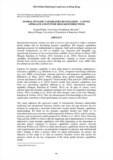

PARTNER
검증된 파트너 제휴사 자료
GLOBAL DYNAMIC CAPABILITIES REVITALIZED – A NOVEL APPROACH AND FUTURE RESEARCH DIRECTIONS
방대한 850만건의 자료 중 주제별로 만들수 있는 최적의 산출물을 해피 캠퍼스에서 체험 하세요 전문가의 지식과 인사이트를 활용하여 쉽고 폭넓게 이해하고 적용할수 있는 기회를 놓치지 마세요
3 페이지
최초등록일 2016.08.09
최종저작일
2016.07

-
 * 본 문서는 배포용으로 복사 및 편집이 불가합니다.
* 본 문서는 배포용으로 복사 및 편집이 불가합니다.
미리보기
서지정보
· 발행기관 : 글로벌지식마케팅경영학회(GFMC)
· 수록지 정보 : Global Marketing Conference
· 저자명 : Gregor Pfajfar, Maciej Mitręga
영어초록
International business ventures are able to survive and succeed in today’s turbulent
global market only by developing dynamic capabilities. The dynamic capabilities
paradigm proposes for multinationals to integrate, build and reconfigure internal and
external competencies as well as tangible (e.g. financial) and intangible (e.g.
reputational) resources to face environmental volatility (Teece, Pisano & Shuen, 1997;
Morgan, Katsikeas & Vorhies, 2012; Leonidou et al., 2015). However, dynamic
capability development needs the organizational “capacity to extract economic
benefits from current resources and to develop new capabilities” (Luo, 2000). Here
the scholars do not offer a unified view.
Capacity for dynamic capability is most often linked to knowledge exploitation /
innovation capability (e.g. Monferrer et al., 2015), competitor knowledge utilization
(e.g. Luo, 2000), or knowledge- sourcing, generative and integrative capabilities (e.g.
Michailova & Zhan, 2015). When speaking about global dynamic capabilities,
Lawson and Samson (2001) proposed 7-factor model, Chen and Law (2009) 6-factor
model, and Leonidou et al. (2015) 5-factor model. New dynamic capabilities were
born, e.g. networking capability (Mitrega et al., 2012), international marketing
capability (Morgan, Katsikeas & Vorhies, 2012), etc. In spite of various views,
scholars agree that dynamic capabilities generate new forms of competitive advantage
(Teece, 2014; Leonidou et al., 2015) and offer strategic value to the firm (Morgan,
Katsikeas & Vorhies, 2012). Thus, the advancement of the knowledge in this area will
significantly contribute to better performance of export ventures in the future.
This study addresses the equivocal results of international (business relationship) marketing and international business scholars and closes the gap between the two domains by proposing a structured framework towards global dynamic capabilities understanding. We build on two dynamic capability models (see Table 1): (1) antecedents-processes-outcomes model proposed by Eriksson (2014); and (2) strategy, structure and environment model proposed by Wilden et al. (2013). First, following Fang and Zou (2009) we believe that the magnitude and complementarity of resources deployed to create dynamic capabilities will differ depending on the antecedents or outcomes phases compared to dynamic capabilities creation process. Second, following Wilden et al. (2013) we claim that dynamic capabilities need to be aligned with organizational structure, environmental (competitive) intensity and multinational firm’s strategy to have a positive effect on export performance. In essence, the objective of this study is to offer an extensive literature review and answer the question, which are the key components of the future global dynamic capabilities model.
At the end, this multidisciplinary study offers the directions for future research in the
dynamic capabilities area. We suspect future studies will focus on the comparison
between developed and emerging markets (Khalid & Larimo, 2012), as the level of
turbulence in these markets differs leading to unique conditions for multinationals’
dynamic capabilities development. Furthermore, the comparison between
headquarters’ and subsidiaries’ dynamic response to cultural, psychic and economic
differences (Leonidou et al., 2015) might reveal other factors that equally importantly
impact the export marketing strategy implementation effectiveness (Morgan,
Katsikeas & Vorhies, 2012). Finally, we may expect more multidisciplinary studies in
the future (Teece, 2014), particularly in the overlapping dynamic fields of
(international) management, (business relationship) marketing, and humanistic studies.참고자료
· 없음태그
-
자료후기
Ai 리뷰지식판매자의 콘텐츠는 다양한 주제를 깊이 있게 다루고 있어 지루할 틈이 없습니다. 매번 새로운 인사이트를 제공해 주어 학습이 즐거워지고 있습니다. 학습 후 실제로 과제나 레포트에 활용할 수 있어 매우 만족스럽습니다. 앞으로도 계속해서 이용할 예정입니다! -
자주묻는질문의 답변을 확인해 주세요

꼭 알아주세요
-
본 학술논문은 (주)코리아스칼라와 각 학회간에 저작권계약이 체결된 것으로 AgentSoft가 제공 하고 있습니다.
본 저작물을 불법적으로 이용시는 법적인 제재가 가해질 수 있습니다. -
해피캠퍼스는 구매자와 판매자 모두가 만족하는 서비스가 되도록 노력하고 있으며, 아래의 4가지 자료환불 조건을 꼭 확인해주시기 바랍니다.
파일오류 중복자료 저작권 없음 설명과 실제 내용 불일치 파일의 다운로드가 제대로 되지 않거나 파일형식에 맞는 프로그램으로 정상 작동하지 않는 경우 다른 자료와 70% 이상 내용이 일치하는 경우 (중복임을 확인할 수 있는 근거 필요함) 인터넷의 다른 사이트, 연구기관, 학교, 서적 등의 자료를 도용한 경우 자료의 설명과 실제 자료의 내용이 일치하지 않는 경우
“Global Marketing Conference”의 다른 논문도 확인해 보세요!
-
THE ROLES OF GREEN PACKAGING IN UGLY FOOD PURCHASE INTENTION: A CONCEP.. 22 페이지
-
THE IMPACT OF INDUCED AWE ON ETHICAL TOURIST BEHAVIORS 5 페이지
-
A BIBLIOMETRIC ANALYSIS OF SPIRITUAL TOURISM RESEARCH 15 페이지
-
SOCIAL NETWORK ANALYSIS AND RESPONSE TIME TESTING: CONSPIRACY THINKING.. 11 페이지
-
THE EFFECTS OF PARA-SOCIAL INTERACTION ON ONLINE CELEBRITY ENDORSEMENT 3 페이지
문서 초안을 생성해주는 EasyAI
